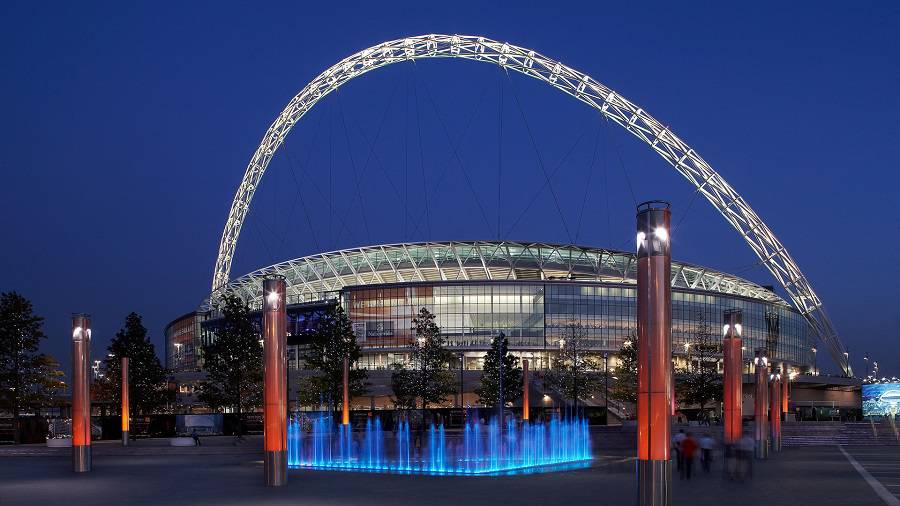Completed in 2007, the Wembley Stadium in London was not only built to welcome 1.5 million football and rugby fans each year, but it is also the UK’s leading venue for music concerts. The landmark feature that will inspire all of these visitors is the arch that sits above the north stand.
Wembley Stadium is popularly known as the home of the English football and it is National Stadium of England. It is not only popular for organizing grand football events but it also holds musical concerts, cultural events, and public gatherings. Overall capacity of the stadium is approximately close to 100,000 audience, seated and standing both included. The likes of Metallica, AC/DC, U2, Green Day, and Madonna have performed live at the new Wembley Stadium in front of huge crowds. As far as sports are concerned, the new Wembley Stadium is going to host the finals of the London Olympics in 2012. In 2011, it hosted the finals of the Champions League, witnessing the battle for supremacy between the Barcelona and Manchester United football clubs.
It is the second largest stadium in Europe (after Camp Nou) and the largest stadium with every seat under cover in the world. The final cost for construction was close to £800 million. The project was funded by Sport England, Wembley National Stadium Limited) the Football Association, the Department for Culture Media and Sport, and the London Development Agency. World Stadium Team was responsible for the design of the new Wembley Stadium including the arch. The arch of the stadium is a civil engineering wonder, as it is huge and beautifully designed, which adds more flavor to the stadium’s aesthetic appearance.

Building the Arch
The Wembley Stadium Arch when lit on a clear evening can be seen in Canary Wharf, 13 miles away. At its highest point, the arch is 133 meters high and it is made of 504 steel tubes and 41 steel rings. The arch is large enough for the London Eye to be rolled underneath. The steel was made in Britain and was supplied by Corus. The pre-fabrication of the entire arch was completed by Cleveland Bridge UK in Darlington and then transported to Wembley for the final construction. It took engineers ten months to complete the assembly of the arch at Wembley. The steel tubes needed to be cut to length on site. The tubes were then connected to the rings in sections. Sections of three rings and the corresponding tubes were assembled together to form thirteen modules. The modules were then assembled and welded together. The tapered end of the arch, called the “pencil end,” was then welded to each end of the arch structure. The pencil ends are attached to 70 ton hinges that are embedded into concrete bases.

In order to raise the arch into place, engineers needed to lift it in four stages. The arch was first raised to 30 degrees. Next, it was winched to a position of 65 degrees. In this position, temporary restraining cables were put in place to control the position of the arch. The arch was then raised to 100 degrees and the three main turning struts were lowered. Finally, the arch was raised to 112 degrees, and the last two turning struts were lowered. The arch was held in this position by restraint cables until the roof was erected and connected. The entire lifting process was controlled by computers to ensure even and simultaneous progress of all sections of the structure. Surveys and checks were constantly made by engineers throughout the process. The pencil end of the arch rests on a bearing that permits rotational movement in three rotational directions.
The long span and architectural intent of the arch required it to be designed to be as efficient, slender and lightweight as possible. Keeping a check on weight of the arch was the most crucial part of the construction process. Prosteel and CAD were used to design, develop, and analyze the structural stability of the arch. On the whole, the geometry of the arch has been optimized to provide well-organized support to the roof, maintain adequate tension in the cable systems, and to clear the bowl whilst keeping its abutments within the stadium precinct.
The arch is fascinating to look at and is also a structural support of the stadium. The entire weight of the north roof, 60% of the weight of the southern side portion, and the retractable roof’s weight are supported by the arch. The arch also ensures that the audience view is not obstructed as with an arch overhead, there is no need for pillars to be constructed and hence an unobstructed view for the audience. The Wembley stadium arch is a phenomenal achievement of not only the civil engineers associated with the project but it belongs to every person who contributed to make this wonder become a reality.



Comments are closed